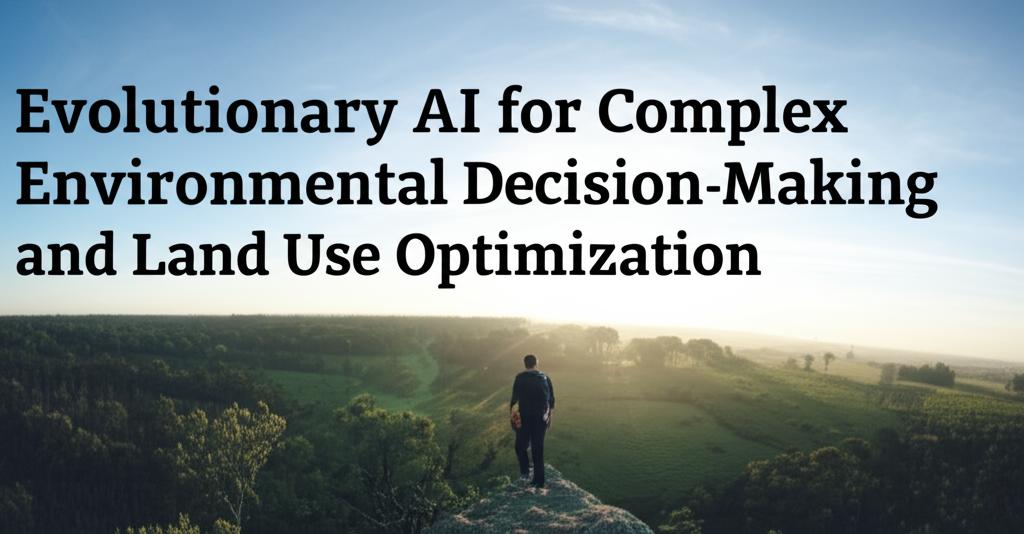The pursuit of sustainable environmental management and optimal land use strategies in an increasingly complex world demands innovative solutions. Evolutionary AI, a branch of artificial intelligence that employs principles of natural selection and genetics, is emerging as a powerful tool to address these multifaceted challenges. By simulating evolutionary processes, these algorithms can explore vast and intricate solution spaces, identifying robust and efficient strategies for environmental decision-making and land resource allocation.
Recent advancements highlight the growing sophistication and applicability of evolutionary AI in this domain. Researchers are developing and refining algorithms like genetic algorithms (GAs), non-dominated sorting genetic algorithm III (NSGA-III), and other multi-objective evolutionary algorithms (MOEAs) to tackle complex, real-world problems. These approaches are particularly adept at handling multiple, often conflicting, objectives inherent in environmental planning, such as maximizing economic benefits while minimizing ecological damage or optimizing carbon storage alongside agricultural production.
One of the key strengths of evolutionary AI lies in its ability to model and analyze complex systems. Land use change, for instance, is driven by a multitude of interacting socio-economic and environmental factors. Evolutionary algorithms can process vast datasets, including historical land use patterns and environmental data, to identify optimal land allocation strategies that balance competing demands such as urban development, agricultural needs, biodiversity conservation, and climate change mitigation. For example, researchers have successfully used evolutionary AI to develop land use plans that maximize carbon storage while minimizing economic disruption, offering valuable insights for policymakers striving to achieve global sustainability goals.
The integration of evolutionary AI with other cutting-edge technologies like machine learning, deep learning, Internet of Things (IoT), and geographic information systems (GIS) is further enhancing its capabilities. This synergy allows for more accurate data collection, sophisticated analysis, and the development of dynamic models that can adapt to changing environmental conditions and policy priorities. For instance, AI-powered smart grids are optimizing energy consumption and renewable energy integration, while AI-driven analytics are improving the efficiency of logistics and reducing emissions.
Recent applications demonstrate the diverse potential of evolutionary AI:
- Optimizing Land Use Allocation: Evolutionary algorithms are being used to generate optimal land use plans by considering factors like economic return, carbon emissions, accessibility, and ecological integrity. Improved versions of algorithms like NSGA-III are specifically designed to handle constraints related to the size and contiguity of different land use types.
- Enhancing Environmental Monitoring and Management: AI, including evolutionary computation, plays a crucial role in analyzing data from sensors and satellites for applications like air and water quality monitoring, predicting natural disasters, and managing waste.
- Supporting Sustainable Agriculture: AI-based solutions are helping to optimize resource use in agriculture, including water, fertilizers, and pesticides, leading to improved yields and reduced environmental impact.
- Climate Change Mitigation and Adaptation: Evolutionary AI contributes to climate modeling by processing large datasets and identifying patterns in weather and emissions. It can also help design and evaluate policies aimed at reducing greenhouse gas emissions and adapting to the impacts of climate change.
Despite its promise, the application of evolutionary AI in environmental decision-making also faces challenges. These include the need for high-quality, comprehensive data, the computational intensity of some algorithms, and the importance of developing explainable AI (XAI) models whose decision-making processes are transparent and understandable to policymakers and stakeholders. Ensuring ethical considerations, such as mitigating biases in data and algorithms, is also paramount.
The future of evolutionary AI in complex environmental decision-making and land use optimization appears bright. Ongoing research focuses on developing more efficient and robust algorithms, integrating them more seamlessly with other AI and data science tools, and making them more accessible to decision-makers. As these technologies continue to mature, they will undoubtedly play an increasingly critical role in navigating the complexities of environmental stewardship and fostering a more sustainable future.

